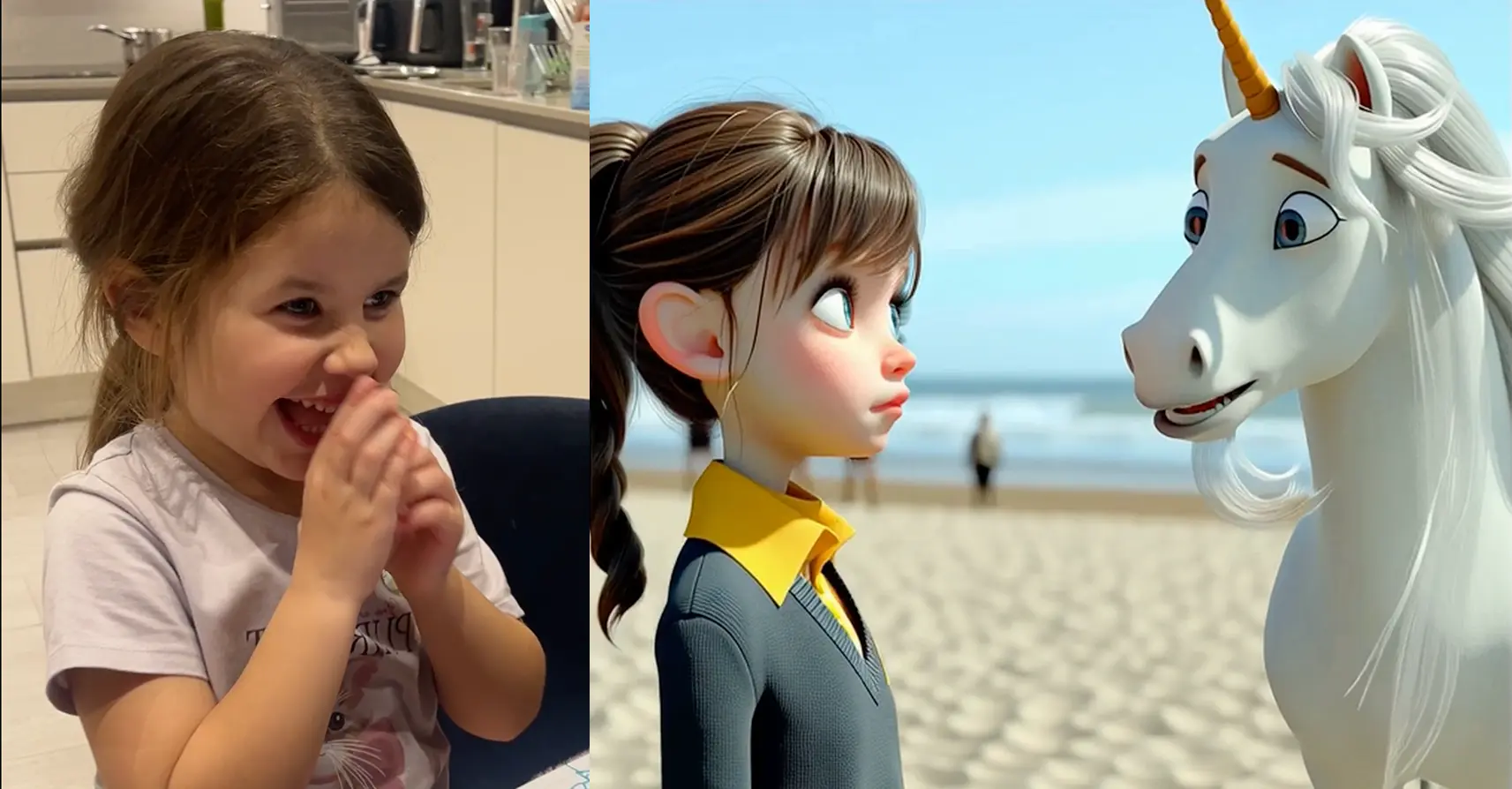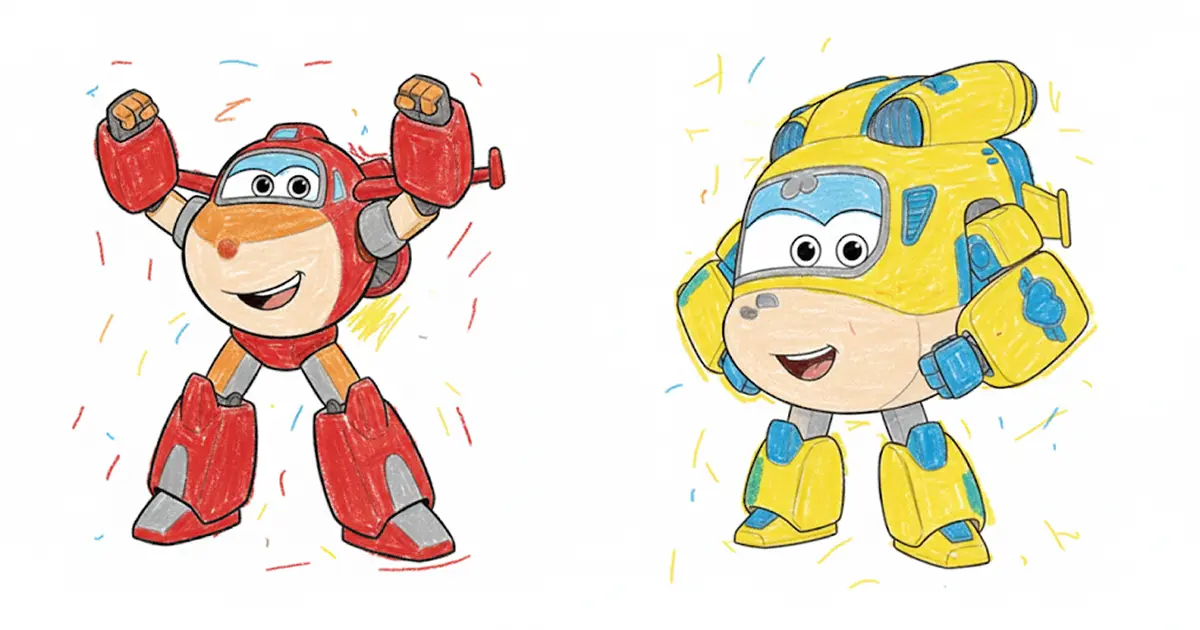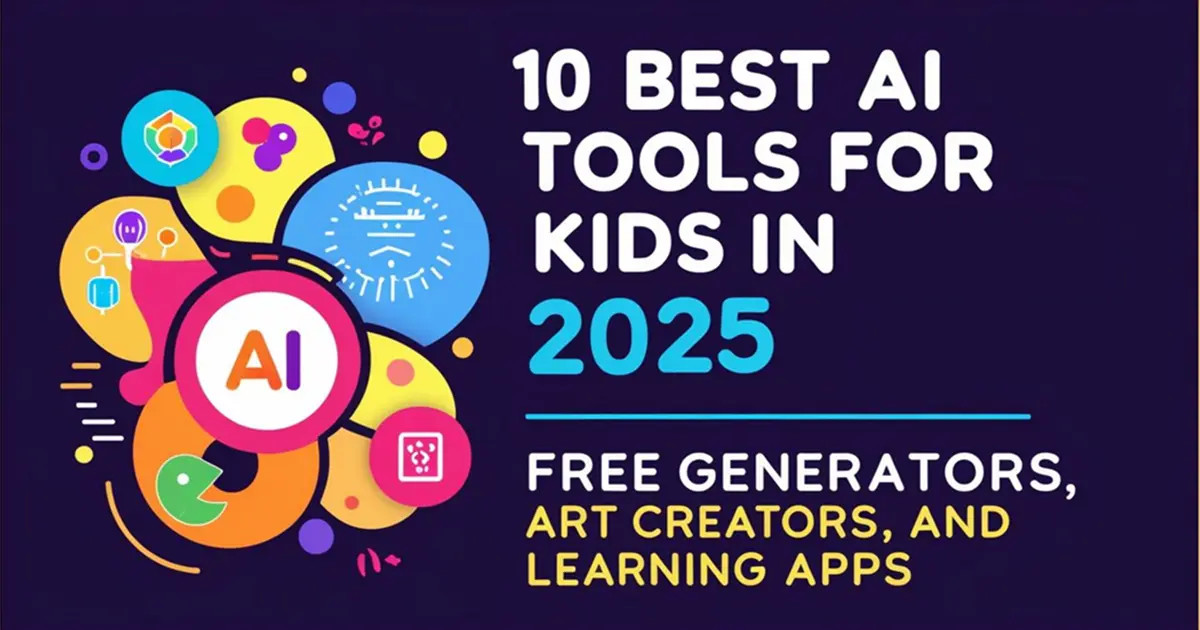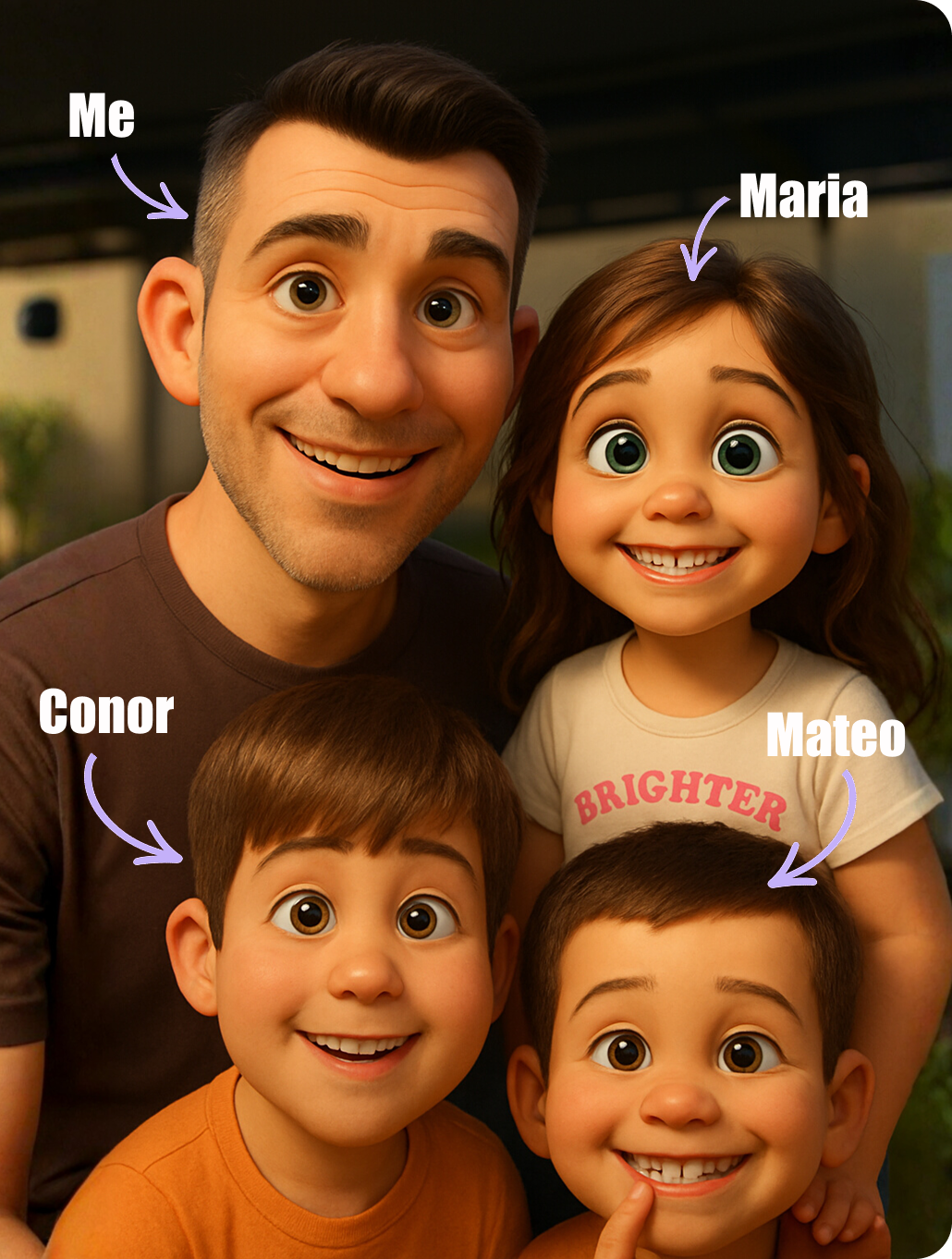We Created a 20-Second Animation of My Daughter's Unicorn Story Using AI

My 5-year-old daughter is obsessed with unicorns.
She draws them constantly. Unicorns, rainbows, love hearts. All day, every day. So last week, I asked her: "What story would you like to bring to life?"
She came up with this: She's at the beach near our house, gets separated from us, turns around and sees a unicorn. The unicorn flies her home.
Using Midjourney's animation feature, we turned her story into a 20-second animated video with her as the main character.
Her reaction when she saw herself riding the unicorn? Pure amazement. She wanted to watch it again. Then again. Then she asked: "Make another one?"
Here's exactly how we did it, what worked, what didn't, and whether it's worth the $10/month.
What you'll need
Tools:
- Midjourney account ($10/month Basic plan minimum)
- 30-60 minutes for initial project
Your Child's Input:
- Story idea they're excited about
- Key scenes they want to see
- Character details (what they're wearing, where they are)
Parent Skills:
- Willingness to iterate (expect failed attempts)
- Basic web navigation
- Patience with prompt writing
- Ability to translate kid ideas into AI prompts
Optional:
- Screen recording software to capture child's reaction
- Video editing app to combine animation and reaction (I used split-screen)
Our creative process
The Story Maria Wanted
We live close to the beach. Maria's story: She's at the beach, gets separated from us, turns around and sees a unicorn. The unicorn offers to fly her home.
Simple, clear, emotionally engaging for a 5-year-old.
Breaking It Into Scenes
I translated her story into 4 key moments:
Each scene would become a 5-second animation extension.
Step-by-step: Image creation
📸 Step 1: Upload Reference Photo
Midjourney's OmniReference feature lets you upload a photo of your child. The AI uses it as a reference to maintain consistency across generated images.
I uploaded a clear, front-facing photo of Maria showing her brown hair and blue eyes.
🎨 Step 2: Choose Your Style (Trial and Error)
I started with claymation style because I thought it would look fun and tactile.
My prompt:
"A claymation girl with brown hair and blue eyes. You see her full body and she is on a beach at the golden hour."
Result: Generated 16 different variations. None looked right. The style didn't match the vision.
Time wasted: About 10 minutes going down the wrong path.
💡 Step 3: The Pro Tip That Changed Everything
Instead of writing prompts from scratch, I browsed Midjourney's gallery of existing images.
Found a Pixar-style image of a girl I loved. Clicked on it. Copied the entire detailed prompt. Then edited it to match Maria's appearance.
Stolen and customized prompt:
"Pixar-style 3D render of a 5-year-old girl with brown hair and bright blue eyes, wearing a gray tracksuit and yellow t-shirt, standing on a sandy beach during golden hour, soft lighting, detailed facial features, child-friendly animation style, full body visible, cheerful expression, photorealistic textures --ar 16:9"
Result: Perfect image on the second try (8 more generations).
This is the breakthrough: Don't write prompts from scratch. Copy proven ones and customize.
🎬 Step 4: Refine the Scene
Once I had the base image of Maria on the beach, I made small adjustments:
Total generations for final image: 8 (after abandoning the 16 claymation attempts).
Step-by-step: Animation
🎞️ Step 5: Access Animation Settings
In Midjourney, click on your final image. Go to settings. You'll see two animation options:
Auto Animation: Creates 4 variations automatically (5 seconds each), no input from you.
Manual Animation: You write prompts describing what should happen.
I chose Manual for creative control.
📝 Step 6: Write Your First Animation Prompt
Start simple. Describe one clear action.
My prompt:
"She turns around and sees a unicorn standing behind her, her face shows amazement and wonder"
Midjourney generates 4 variations. I picked the best one.
Result: Perfect 5-second clip of Maria turning, seeing the unicorn, face lighting up with shock and delight.
Attempts needed: One. It worked.
➕ Step 7: Extend the Animation (Up to 20 Seconds)
Midjourney lets you extend animations up to 4 times (5 seconds each equals 20 seconds total). The transitions between extensions are seamless.
Extension 1 prompt:
"She climbs onto the unicorn's back and they fly up into the air above the beach"
Extension 2 prompt:
"The unicorn lands in front of a house"
Extension 3 prompt:
"She turns toward the house, waves goodbye to the unicorn, and walks inside"
Each extension worked on the first try. Total time for all animations: 15-20 minutes.
💾 Step 8: Download and Combine
Download the final 20-second animation. I also recorded Maria watching it and created a split-screen video (animation on top, her reaction below).
What worked
OmniReference Maintained Consistency
Uploading Maria's photo as a reference meant she looked like herself across all generations. Same brown hair, same blue eyes, same facial features.
Without this, the AI would create a generic "girl" without the personal connection.
Copying Proven Prompts Saved Hours
After 16 failed claymation attempts, I switched strategies: copy successful prompts from the gallery and customize them.
This gave me the descriptive language I was missing ("photorealistic textures", "soft lighting", "detailed facial features").
Lesson: Don't reinvent the wheel. Steal good prompts.
Simple Animation Prompts Worked Best
I didn't need flowery language. "She climbs onto the unicorn's back" worked better than "she gracefully mounts the majestic creature."
Clear, simple action descriptions equal better results.
Extensions Created Seamless Transitions
The 4 extensions blended together naturally. It looks like one continuous 20-second video, not 4 separate clips stitched together.
Fast Generation Times
Each image took about 60 seconds to generate. Animations took 2-3 minutes each. No long waits.
What didn't work
Claymation Style Was a Dead End
Sixteen generations trying to make claymation work. None looked right. The style didn't fit the story.
Time wasted: 10 minutes
Lesson: Sometimes the style is wrong, not your prompting skill. Be willing to pivot.
Writing Prompts from Scratch Is Hard
My initial attempts were too vague or too complicated. I didn't know the right descriptive vocabulary.
Beginners will struggle without examples to work from. The learning curve is real if you don't copy existing prompts first.
Extensions Aren't Editable
Once you commit to an animation extension, you have no way to go back and tweak it. You'd have to regenerate the entire sequence.
Not a dealbreaker, but worth knowing. I got lucky with each extension working on the first try.
Maria's reaction
I didn't show her any work-in-progress. I waited until the full 20-second story was ready.
Yesterday, I sat her down, reminded her of the story she wanted to create, and pressed play.
Her face lit up.
Pure amazement as she watched herself turn around, see the unicorn, climb on its back, fly through the air, land at our house, wave goodbye.
She wanted to watch it again. Then again.
Then she asked: "Make another one?"
The verdict: She wants more. She already has ideas for the next story (something about a rainbow castle, naturally involving unicorns).
The split-screen video of her watching herself in the animation captures pure wonder. It's a moment I'll keep forever.
Pricing breakdown
I'm on the Basic plan: $10/month (billed monthly)
Annual option: $8/month if you commit for a year ($96 upfront)
Four tiers available:
For family storytelling, Basic is plenty. I'm considering switching to the $8/month annual plan because I already see us using this regularly.
Value comparison:
Custom animation services charge $500+ for a 20-second clip. We created this for a $10 monthly subscription.
Even if we only make 2-3 animations per month, it's incredible value.
Why this workflow works for families
This isn't about creating a cool video. It's about validating your child's creativity and showing them their ideas matter.
Maria told me a story. I helped bring it to life. She saw herself as the hero of her own adventure.
This builds confidence, storytelling skills, and excitement about creating.
The learning curve is real but worth it
My first 16 attempts failed. If I'd given up there, we wouldn't have this magical video.
The tool rewards persistence and stealing good prompts from the gallery.
Once you understand the workflow (copy proven prompts, customize, animate, extend), it becomes repeatable.
Next time will take 15 minutes, not 30, because I know what works.
This opens up new creative possibilities
We now turn any of Maria's stories into animations:
- Her bedtime stories
- Adventures she imagines during play
- Stories from books we read (reimagined with her as the character)
- Memories from family trips
The $10/month becomes a creative toolkit, not a one-off project.
Getting the most out of Midjourney
Before you start:
- Have your child tell you the full story out loud. Record it if needed. This helps you identify key scenes.
- Take a clear, well-lit reference photo of your child (no hats, sunglasses, or shadows).
- Browse the Midjourney gallery FIRST to find styles you like. Don't start from scratch.
- Set realistic expectations: First project will take 30-60 minutes. Future projects will be faster.
During image creation:
- Copy successful prompts from the gallery, then customize with your child's details.
- Always include aspect ratio tag (--ar 16:9) for widescreen animations.
- Generate in batches of 4, pick the best, refine from there.
- If a style isn't working after 10+ attempts, switch styles entirely (like I did from claymation to Pixar).
- Keep your child's outfit simple in the prompt (easier for AI to render consistently).
For animations:
- Start with Manual animation for creative control.
- Describe one clear action per extension ("she climbs onto the unicorn's back").
- Avoid flowery language. Simple, direct prompts work best.
- Preview all 4 generated variations before committing to an extension.
- Don't chase perfection on the first project. See if your kid even likes the result before refining.
What I'd do differently next time:
- Skip experimenting with styles. Go straight to Pixar (I know it works for kids' faces).
- Save all successful prompts in a Google Doc for reuse.
- Film Maria's reaction from the start (I only thought to record halfway through).
- Involve her more in the prompt writing process (she describes what she wants to see).
Platform comparison
DALL-E 3 (via ChatGPT, $20/month)
- Pros: Easier prompting, integrated with ChatGPT, safer content filters, simple web interface
- Cons: No animation feature, less detailed images, more generic artistic style
- Best for: Quick illustrations for younger kids (5-7), simpler projects
Leonardo AI (Free tier available)
- Pros: Free tier with daily credits, good image quality for still images
- Cons: No native animation feature, steeper learning curve, inconsistent character rendering
- Best for: Budget-conscious families testing AI art, not animation
Runway ML ($12/month)
- Pros: Professional video tools, AI video generation, green screen removal
- Cons: More complex interface, geared toward video editors, expensive for casual use
- Best for: Older kids (10+) learning video production, not simple storytelling
Midjourney ($10/month)
- Pros: Best image quality for characters, animation feature with extensions, OmniReference for face consistency, seamless transitions, beautiful easy-to-use interface
- Cons: Learning curve for prompting, requires practice
- Best for: Parents willing to learn, kids 5-12 who love storytelling, repeated use
For our family, Midjourney's animation feature was the deciding factor. Being able to turn Maria's story into an actual moving video, not static images, made it feel real to her.
Common issues and solutions
Problem: Generated images don't look like my child
Solution: Make sure you're using the OmniReference feature correctly. Upload a clear, front-facing photo with good lighting. Also specify hair color, eye color, and age in your prompt explicitly ("5-year-old girl with brown hair and blue eyes").
Problem: Style isn't working after many attempts
Solution: Switch styles entirely. I wasted 16 generations on claymation before switching to Pixar. If it's not working after 10 tries, the style is wrong for your vision.
Problem: Prompts are too vague or too complicated
Solution: Copy successful prompts from the Midjourney gallery first. Click on images you like, copy the full prompt, then customize with your child's details. This gives you the descriptive language you're missing.
Problem: Animation doesn't match what I wanted
Solution: Simplify your animation prompt. Instead of "gracefully climbs aboard the majestic unicorn", try "climbs onto the unicorn's back". Clear, simple actions work better.
Problem: Extensions don't flow smoothly together
Solution: Make sure each extension describes a logical next action from the previous one. Midjourney creates transitions automatically, but the actions need to be sequential (turn around, see unicorn, climb on, fly away).
Problem: Interface navigation is confusing
Solution: Start with the Explore page to see examples. Use the Create tab to generate images. Your generations appear in your personal gallery. The interface is intuitive once you spend 5-10 minutes exploring.
Problem: Images are square instead of widescreen
Solution: Always include --ar 16:9 at the end of your prompt for widescreen format. This is critical for animations looking good on screens.
Problem: Child lost interest before project was done
Solution: Don't show work-in-progress. Complete the animation first, then show them the final result all at once. The "wow" factor is much stronger with the complete story.








